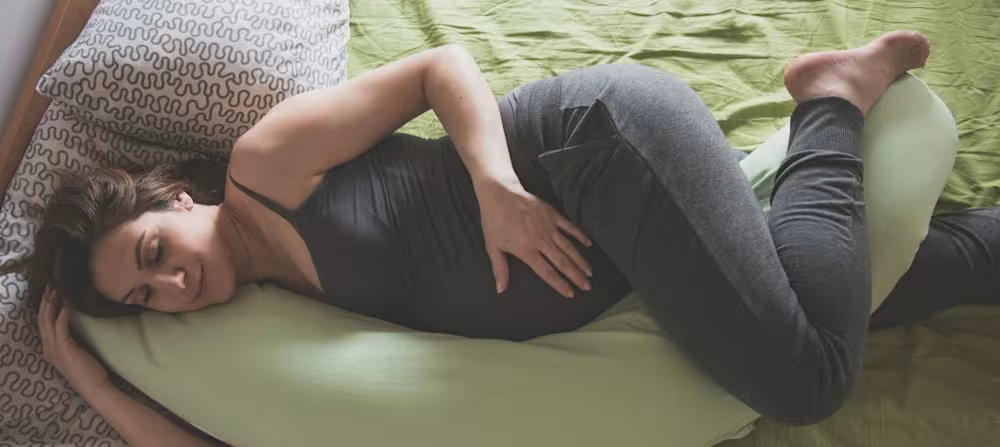Best and worst sleeping positions during pregnancy
Updated Aug 14, 2025

Sleeping during pregnancy can be a bit of a conundrum: you’re exhausted, and your body and mind crave more sleep. However, whether it’s the pregnancy hormones, heartburn, and cramps keeping you awake or the discomfort that comes with a growing belly… You just can’t seem to consistently get that shut-eye. Cool, thanks, biology!
You’re not alone. According to the American Pregnancy Association [], 78% of pregnant women have insomnia while sleeping. This is supported by numerous research studies conducted globally.
Turns out, certain pregnant sleeping positions can ease discomfort and promote better sleep. One of the best sleeping positions includes side lying with a pillow to improve blood flow, and wedge supports to support the spine, hips, and knees in a neutral position. However, there are no hard and fast rules regarding pregnancy pillow use. There will be individual variations with the comfort level and what works best for you.
We do know that sleeping posture can affect the duration and quality of sleep, as poor spinal and hip alignment can lead to increased achiness and pain which will interrupt those sweet dreams like a smack in the face.
Can you hurt the baby in the womb while sleeping?
Many physicians recommend sleeping on the left side during pregnancy, as this places less pressure on the blood vessels that supply the uterus. This advice is largely based on a small sample study [] where women who reported that they did not sleep on their left side had a greater incidence of poor health outcomes for their baby.
Solely sleeping on the left side can be troublesome to moms who are not accustomed to sleeping on their sides – not to mention that when sleeping, we’re not always conscious about what position we wind up in!
A study published in the journal of Obstetrics and Gynecology [] found that back sleeping in early to mid-pregnancy (up to 29 weeks), there was no greater risk of adverse reactions between mothers who sleep on their left side and those who slept on their right or on their backs.
Now, the research is less clear regarding 3rd-trimester sleeping positions. To be safe, side-sleeping in the 3rd trimester is recommended to promote a reduced risk of complications for your baby.
Best positions to sleep during pregnancy
Knowing can make all the difference in terms of comfort! Here are a few ideas:
Position 1: Pillow between legs
A long regular pillow or a pregnancy pillow between the upper thighs creates space in the pelvis and hips. This tends to work quite well for the 1st and 2nd trimesters.

Position 2: Pillow cradling back and front.
A ‘C’ or ‘U’ shaped pregnancy pillow to support the head, neck, and spine, and create alignment and space in the pelvis and hips. This lying position can really ease the pain and discomfort associated with 3rd-trimester sleep.

Position 3: Pillow supporting back
If you are a back sleeper, using a pillow wedge behind your back or using a C or U pregnancy pillow may help prevent you from rolling over and encourage the new habit of side sleeping.

Worst sleep positions in pregnancy
Position 1: Lying on your stomach after the 1st trimester
Prefer to sleep on your tummy? While there’s no evidence to support that stomach sleeping during pregnancy is dangerous, it can be increasingly uncomfortable as the baby grows and the abdomen stretches.
Position 2: Flat-back lying for long periods of time
One small study out of New Zealand [] found that back sleeping may be associated with an increased risk of stillbirth. However, the study was small and of low-quality evidence.
Most obstetricians suggest that most pregnant people in their 2nd or 3rd trimester will naturally feel strange after too long sleeping in a completely flat position and shift. Even sleeping on a slight incline versus flat on the back was associated with little risk to the pregnancy.
Sleep tips for each trimester
Each trimester during pregnancy comes with its own set of sleep challenges, so here are some tips to keep you as rested as possible.
First trimester sleep tips
Those first few weeks of pregnancy can be rough, especially if morning sickness is to blame. And thanks to the sudden surge of hormones like hCG and progesterone, you may be plagued by fatigue during the day but still experience insomnia at night.
Breast tenderness, anxiety, and increased urination can also play a role in disrupted nighttime sleep during the first trimester, so here are some tips to keep in mind:
Limit how much you drink before bed. Since your bladder has kicked into overdrive at this point, cutting back on liquids before bedtime can help decrease the number of bathroom trips.
Avoid scrolling on your phone when it's time to sleep. (Easier said than done, we know!) The blue light from your smartphone can actually suppress melatonin and make it harder to fall asleep.
Keep a few snacks on your nightstand. If a couple of crackers can help ease your nausea during the night, go for it!
Go to bed when you're tired. It sounds simple, but you're much more likely to get a better night's sleep when you're naturally tired. Try not to force yourself to stay up — even if it's only 6 PM. (After all, it's exhausting growing a tiny human!)
Stick to a relaxing bedtime routine. The first trimester is the perfect time to start a calming bedtime routine. Meditation, breathing exercises, reading a book, and light stretching or yoga are all great options to unwind.
Second trimester sleep tips
The second trimester can bring plenty of new struggles, such as heartburn, a rapidly growing belly, and restless leg syndrome (RLS).
Here are some tips to help you power through:
Don't eat too close to bedtime. If heartburn is an issue, lying down after eating makes it easier for acid to travel to your esophagus. Give your body time to digest meals before hitting the hay. You can also prop your head up a little in bed to avoid laying completely horizontally.
Eat smaller meals throughout the day. Instead of three large meals per day, try a "grazing" approach. This can help reduce acid production.
Start sleeping on your side. As your baby bump starts growing, stomach sleeping can become uncomfortable. A pregnancy pillow or wedge may start to come in handy as your little one hits that second trimester growth spurt.
Try to squeeze in a little exercise. If you're dealing with the tingly effects of restless leg syndrome, some moderate exercise during the day (even just a stroll around the block) and stretching before bed can offer some much-needed relief.
Third trimester sleep tips
As you near the end of your pregnancy, your body needs all the rest it can get! Of course, all of the discomfort from your extra big belly, pelvic pain, back pain, and baby rib kicks can make it pretty difficult.
To get as much sleep as possible during the third trimester, here's what you can try:
Pack on the pillows. Pillows are your best friends during pregnancy — and for a good reason! When you use a maternity pillow (or surround yourself with multiple pillows), you support your back and belly while helping to avoid rolling onto your back.
Stay hydrated. Drink plenty of water during the day to help prevent leg cramps at night.
Keep your hips aligned. If pelvic pain makes bedtime miserable, try to sleep on your side with a pillow between your knees to keep your hips aligned, taking pressure off your pelvis.
Try to take it easy during the day. The more you strain your back and pelvis during the day, the more pain you'll feel come bedtime. Your body is going through a lot as you prepare for delivery — remember to give yourself a break!
Takeaway
With the right support (pun intended!), it is possible to find comfort in sleeping during pregnancy. Pregnancy pillows or wedges are often recommended by physicians and physical therapists/occupational therapists to help reduce back, hip, and pelvic pain commonly associated with the later stages of pregnancy. It seems that the safest position during pregnancy for sleeping is lying on your left side.
Pregnancy sleeping positions FAQ
Share article:
Note: The content on this site is for informational purposes only and should not replace medical advice from your doctor, pediatrician, or medical professional. If you have questions or concerns, you should contact a medical professional.







